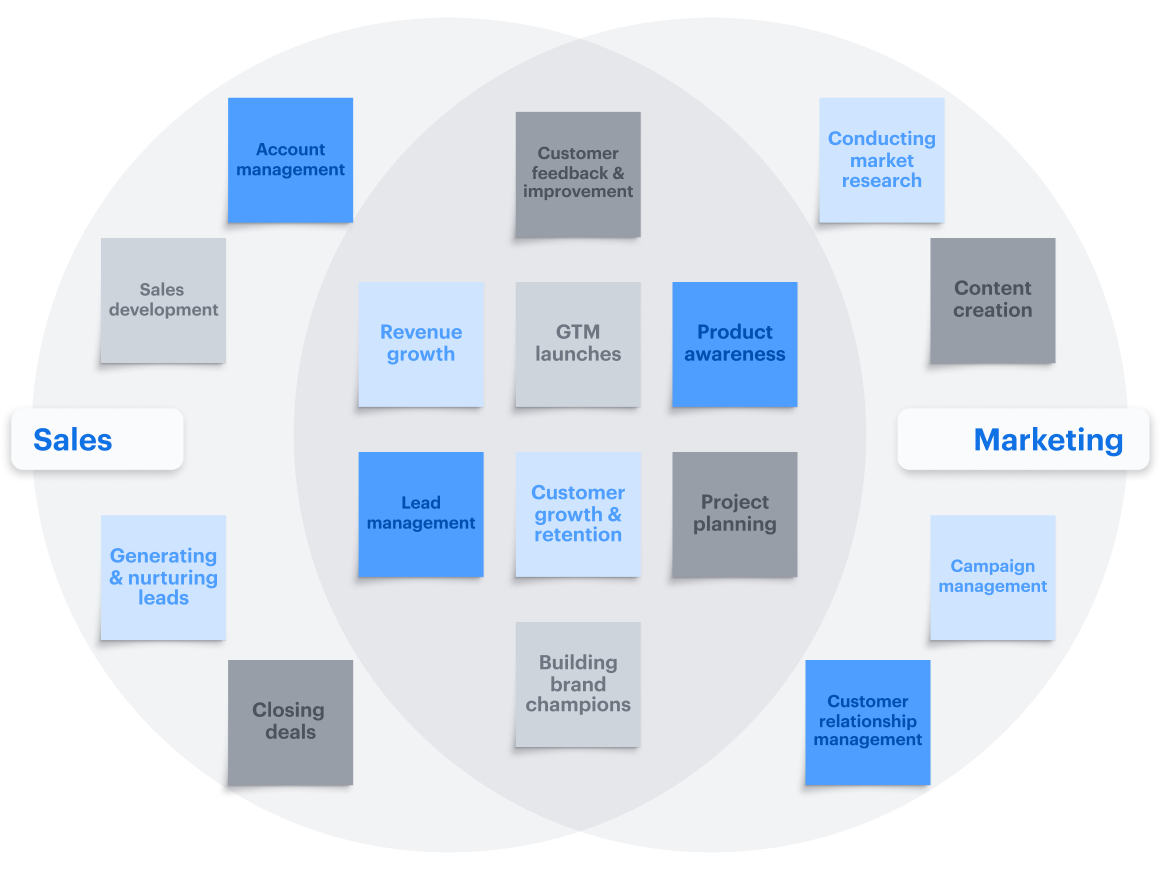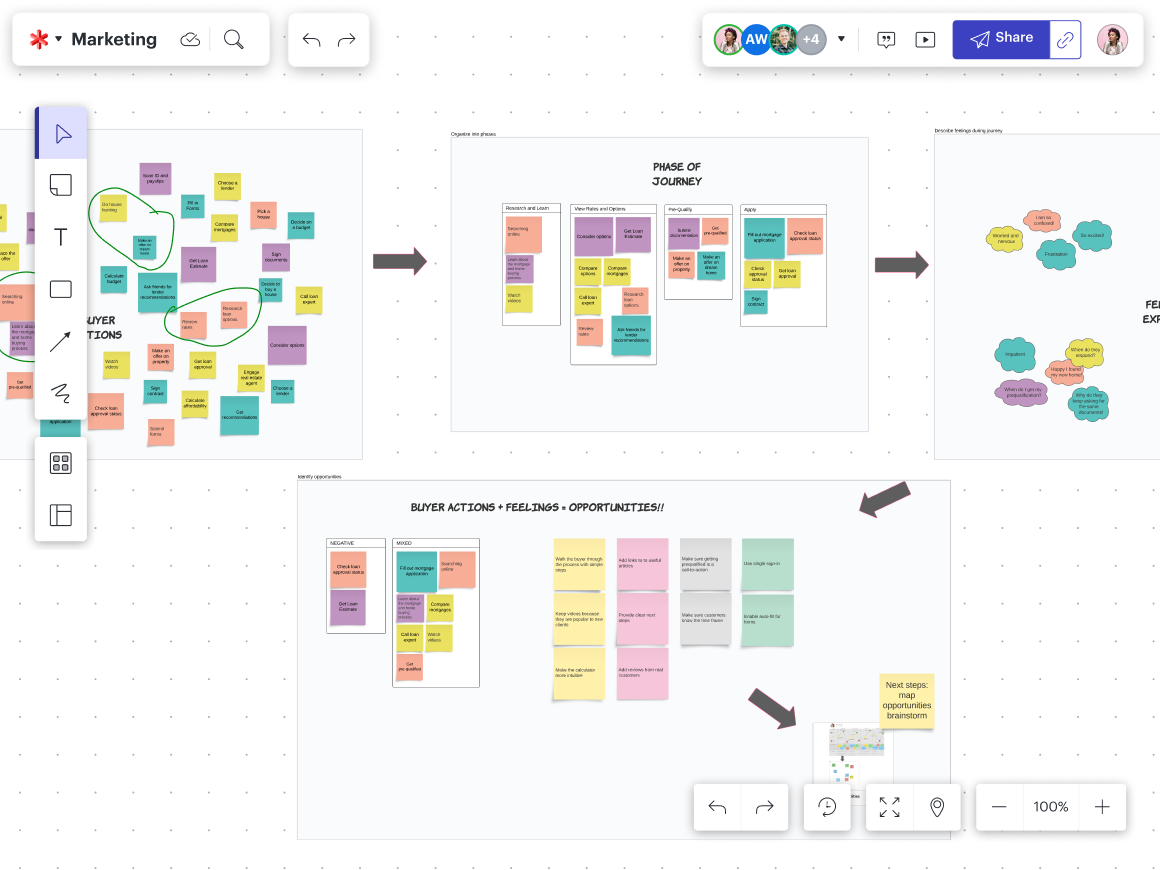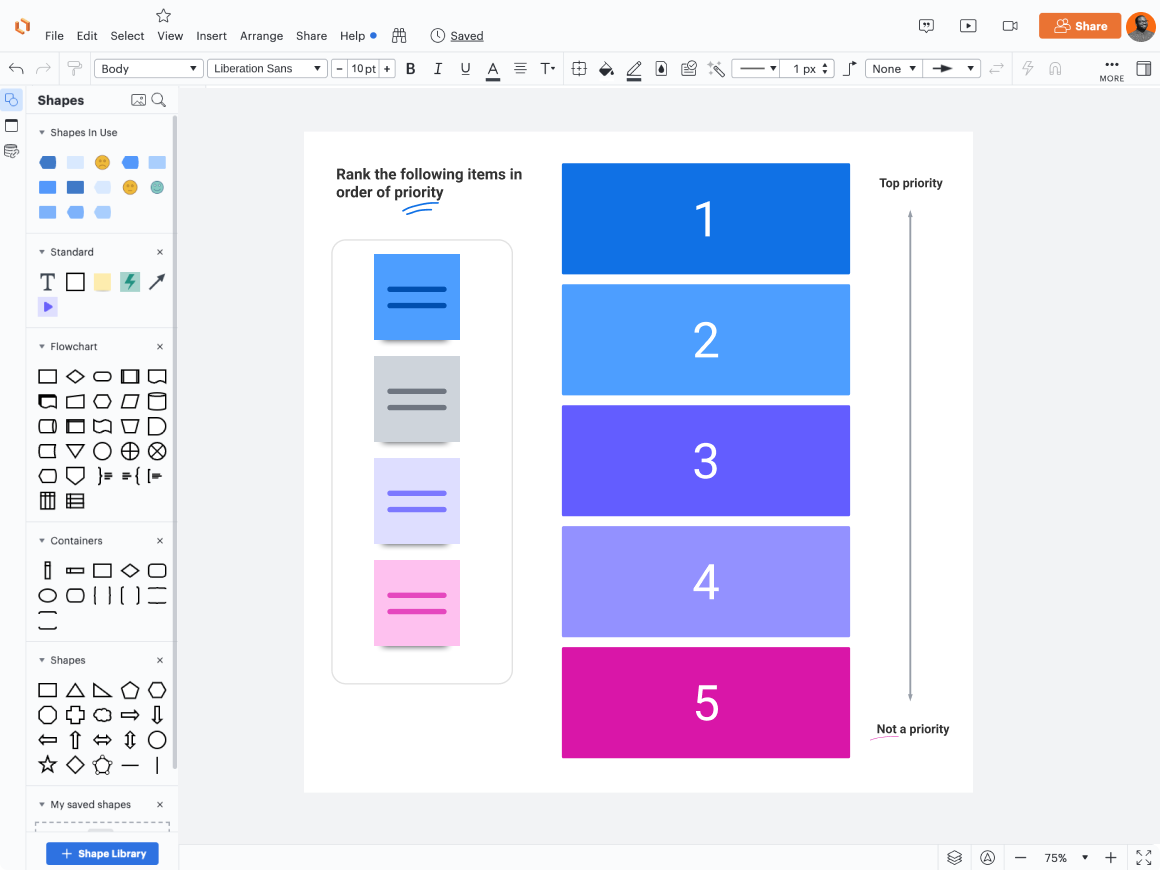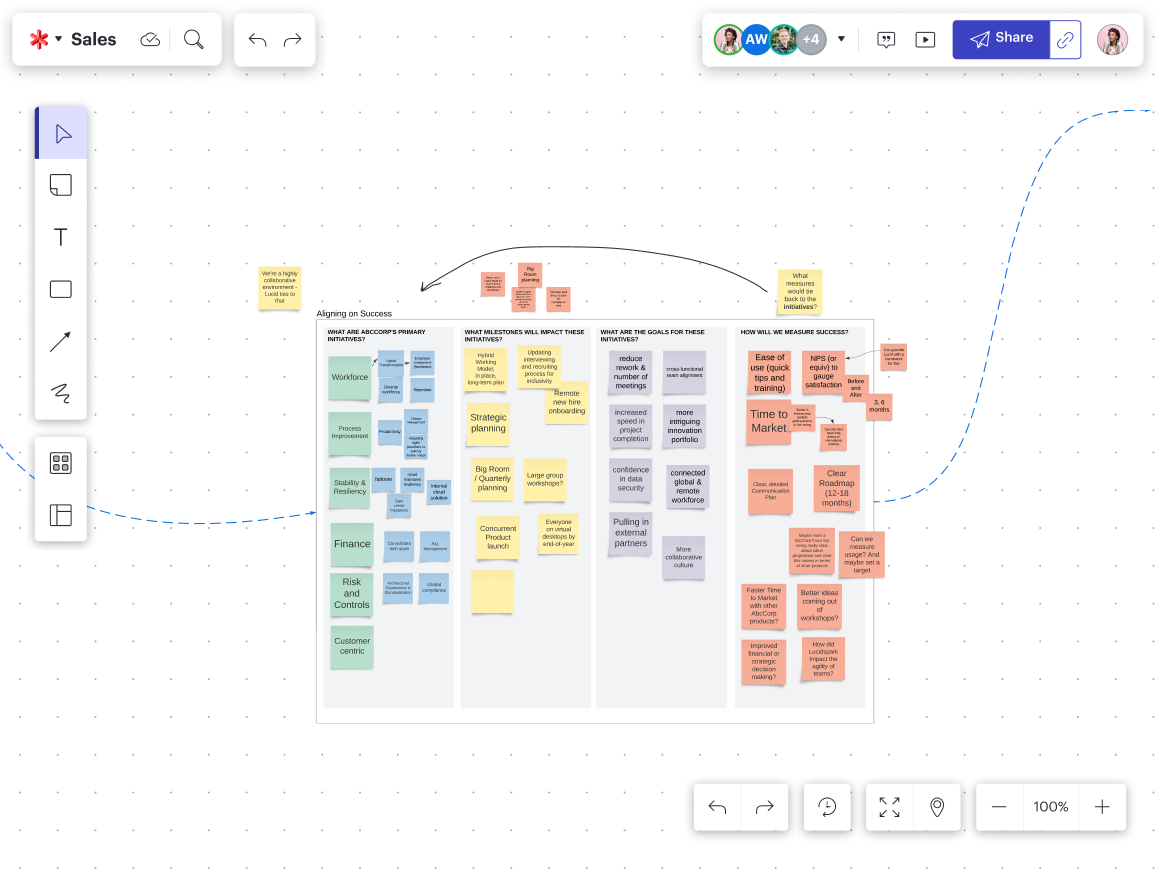
How to improve sales and marketing collaboration
Reading time: about 7 min
Topics:
Both marketing and sales teams are essential forces of a business that drive growth, build customer relationships, and strengthen brand reputation. While both teams have individual functions, there is a clear overlap of goals and objectives. True magic happens when sales and marketing teams join together on strategy and develop a collaborative workflow. But this is easier said than done, especially when many teams today are hybrid and remote.
Sales and marketing teams need a modern approach to collaboration to maximize impact and reach their shared objectives. Let’s explore how they can strengthen collaboration and alignment and, ultimately, increase company revenue.
The overlap: How sales and marketing should align
The primary functions in a sales org include (but are not limited to) generating and nurturing leads, sales development, closing deals, and account management.
The primary functions in a marketing organization include (but are not limited to) conducting market research, content creation, campaign management, and customer relationship management.
Although both departments have unique functions, they overlap in several areas where their goals and efforts can and should align. These areas include:
-
Customer growth and retention
-
Product awareness
-
GTM launches
-
Revenue growth
-
Lead management
-
Project planning
-
Customer feedback and improvement
-
Building brand champions

How to improve sales and marketing collaboration
Take a look at how sales and marketing teams can strengthen their working relationships to achieve greater synergy, increase output, and maximize profitability.
Adopt digital-first collaboration
Before we can tweak systems and processes, we must first examine the fundamentals of how teams collaborate within an organization. With more and more dispersed teams in today’s workforce, a digital-first approach to collaboration is pivotal.
But here’s the thing: Digital-first collaboration isn’t just for remote teams; it’s for all teams. It is a strategic approach to working that promotes alignment and clarity across an organization through the use of digital tools and platforms.
Implementing a mindset of communication and alignment promotes transparency, collaboration equity, innovation, and more. For sales and marketing teams, this looks like:
-
Developing and recording shared goals. Decide where priorities align, what projects are in the pipeline for the quarter, and timelines. From there, both teams can weigh in on the overlap and create goals and metrics to track together, such as marketing leads.
-
Adopting tools that facilitate connection and collaboration in real time. This could look like using a shared document or visual collaboration solution to plan campaigns, document customer feedback, and more.
-
Setting a cadence for regular communication between teams and keeping a digital record of what was discussed. This practice keeps all team members informed, even those who couldn’t make it to a meeting and new teammates who can reference these records for more context later on.

Establish clear communication channels
Set aside time to meet bi-weekly, monthly, or whatever cadence works for both teams. Syncing regularly will help foster alignment and cross-functional connections. Regular communication will also help teams become more comfortable with each other and build trust. Be sure to take meeting notes and record important decisions made to look back on later, or share with teammates who couldn’t make it.
Live syncs shouldn’t be your only point of collaboration, though. Connecting asynchronously is a great way to share updates and information between meetings. In fact, asynchronous collaboration has many benefits, including increased innovation, more efficient workflows, and accommodating a variety of collaboration styles.

Learn more about how to collaborate and align with cross-functional teams.
Take me thereCreate feedback loops
Another way to stay continuously aligned is through feedback loops. Feedback loops help facilitate the continuous improvement of workflows, processes, projects, and more. Bring in managers, project owners, and stakeholders from both sales and marketing teams to gather feedback and workshop through it together.
Feedback loops are also great at gathering multiple perspectives. When we give every stakeholder a voice, teams are able to build better products and uncover new opportunities. Lucid’s Visual Activities are an easy way to do just that. Quickly gauge the group, prioritize tasks, and build connections.


Lucidspark makes collecting, sorting, and iterating feedback a breeze.
See howDocument and share resources
Documentation gets a bad rep, and understandably so. It can be mundane and often time-consuming, but it doesn’t have to be a dreaded process.
Documentation is essential for providing the context team members need and serves as a living blueprint for workflows, structures, and much more. Create a single source of truth between sales and marketing teams by adding important context to a central place, like a team space that houses information and makes it easily accessible to all. Use templates to document intuitively. Whether you are looking to document a process, map out your people, or align on a team vision, utilize our free customizable templates.

Develop shared goals
As mentioned above, marketing and sales teams should create shared goals together. OKRs and KPIs are great ways to measure and achieve success. Doing so keeps teams aligned on the business's overall goals. Teams can hold each other accountable and measure the progress of each OKR and KPI during their regular syncs.

For example, a shared OKR could look like:
OKR: Increase quarterly revenue by X% through greater marketing and sales collaboration and efficiency.
Key results: Increase website traffic by X%, increase conversion rates by X, generate X sales qualified leads, and close X deals.
During each joint team sync, you can revisit these goals and talk about how each team can support each other.
Incorporate visuals
Visuals are a powerful tool for collaboration. Create a shared language between your sales and marketing teams with powerful visuals to enhance communication, connection, and comprehension. Visual collaboration helps:
-
Clarify complex ideas. Visuals help clearly depict processes, systems, and organizations to help your teams better understand the big picture. Lucid’s dynamic features, like layers, allow you to zoom in to get the details you need while keeping your chart or diagram—like an account map—organized.
-
Boost alignment. Working with cross-functional teams can sometimes cause confusion. Visuals work much faster than text-heavy documents to get everyone aligned on campaign plans, key messaging, and other projects.
-
Make meetings more efficient. Cut the chaos and keep meetings focused and productive. Lucid has lots of tools, like timers and voting capabilities, to enhance creativity, promote collaboration, and save time.

Whether you collaborate together or asynchronously, you can make better decisions, faster with visuals.
Use the same collaboration tools
With so many tools on the market claiming to solve your collaboration problems, it can be hard to select apps that bring the most value. As a result, organizations often end up with software they don’t need and different teams using different platforms.
To effectively and efficiently promote collaboration with sales and marketing teams, it’s important to use the same tools. Consolidate your tech stack so that everyone has access to the same apps and can easily access resources and get aligned in one place.
Take a look at the tools in your tech stack and consider the following:
-
Visual collaboration: Using visual collaboration software like Lucid makes it much easier to get everyone on the same page and work towards reaching project goals. But if your company is using multiple visual collaboration apps, that becomes difficult. When teams collaborate in Lucid, they have access to powerful features that can accelerate productivity through every stage of the workflow. Come to an agreement on which collaboration tool you will use to simplify the connection.
-
Instant messaging: Though this may seem obvious, having the same instant messaging software is vital for connecting with other teams. Companies that have a single messaging app, like Slack or Microsoft Teams, can more easily streamline communication rather than hinder it. Sales and marketing teams should set a norm for how they plan to communicate and through which channels.
-
Video recording and conferencing: Consolidate your meeting apps to make synchronous collaboration more convenient. Will you agree to meet over Zoom or Google Meet? Will you record the meeting for those who can’t make it? Similarly, for asynchronous collaboration, using a tool like Loom will give team members clarity and context wherever and whenever they’re working.

Ready to improve cross-functional collaboration? Explore how go-to-market teams use Lucid to win big.
Learn moreAbout Lucid
Lucid Software is the leader in visual collaboration and work acceleration, helping teams see and build the future by turning ideas into reality. Its products include the Lucid Visual Collaboration Suite (Lucidchart and Lucidspark) and airfocus. The Lucid Visual Collaboration Suite, combined with powerful accelerators for business agility, cloud, and process transformation, empowers organizations to streamline work, foster alignment, and drive business transformation at scale. airfocus, an AI-powered product management and roadmapping platform, extends these capabilities by helping teams prioritize work, define product strategy, and align execution with business goals. The most used work acceleration platform by the Fortune 500, Lucid's solutions are trusted by more than 100 million users across enterprises worldwide, including Google, GE, and NBC Universal. Lucid partners with leaders such as Google, Atlassian, and Microsoft, and has received numerous awards for its products, growth, and workplace culture.
Related articles
A step-by-step guide to assembling a cross-functional team
Modern teams work cross-functionally to create integrated campaigns. Learn to bring a cross-functional team together here.
The marketing team’s toolkit for effortless documentation [+ marketing templates]
Get 20+ marketing templates to visualize your workflow, from ideation to execution.
How Lucid’s sales teams use Lucid to close deals faster
See how Lucid’s sales teams use Lucid to host discovery workshops, create account plans, and conduct deal reviews.
How 7 Lucid employees use Lucid for process improvement
Learn from seven Lucidites how they use Lucid for process improvement.